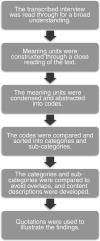Our clock is truly ticking-a qualitative study on patients' experiences of tumor treating fields
- PMID: 40110062
- PMCID: PMC11913639
- DOI: 10.1093/nop/npae102
Our clock is truly ticking-a qualitative study on patients' experiences of tumor treating fields
Abstract
Background: TTFields is recommended internationally for the treatment of glioblastoma. In Sweden, TTFields requires a possibly challenging collaboration between the patient, next-of-kin, healthcare, and the private company providing the device, both from an ethical and practical perspective. Little is known about glioblastoma patients' own experiences of TTFields treatment.
Methods: Semi-structured individual interviews were conducted with 31 patients with glioblastoma who had been offered TTFields by the healthcare. These were analyzed by qualitative content analysis.
Results: Participants described there being multiple actors around them as TTFields users; (1) device prescription from physicians, sometimes providing insufficient information, (2) practical assistance from next-of-kin, necessary to access treatment, (3) home visits from the private company staff for device control, where close bonds between patients and TTFields staff occurred. TTFields treatment created hope and a feeling of control in an otherwise hopeless situation, sometimes evoking worries at the time of planned treatment stop. Some refrained from TTFields or discontinued early due to fear or experience of negative effects on quality of life. Others described finding practical and mental solutions for coping with the treatment in everyday life.
Conclusions: Our study identified a need for better support and information from healthcare providers for TTFields. A solution is necessary for assistance with TTFields for those without support from next-of-kin. The study raises the question of possible advantages of healthcare handling the technical support of the device instead of a private company, thereby avoiding a true or perceived influence on the patient's decision to continue or stop treatment.
Keywords: brain tumor; glioblastoma; patient’s perspective; qualitative research; tumor treating fields.
© The Author(s) 2024. Published by Oxford University Press on behalf of the Society for Neuro-Oncology and the European Association of Neuro-Oncology.
Conflict of interest statement
The authors have no relevant financial or nonfinancial interests to disclose.
Figures
Similar articles
-
A qualitative evaluation of factors influencing Tumor Treating fields (TTFields) therapy decision making among brain tumor patients and physicians.BMC Cancer. 2024 Apr 25;24(1):527. doi: 10.1186/s12885-024-12042-x. BMC Cancer. 2024. PMID: 38664630 Free PMC article.
-
Tumor Treating Fields for Glioblastoma Therapy During the COVID-19 Pandemic.Front Oncol. 2021 May 7;11:679702. doi: 10.3389/fonc.2021.679702. eCollection 2021. Front Oncol. 2021. PMID: 34026655 Free PMC article.
-
Influence of Treatment With Tumor-Treating Fields on Health-Related Quality of Life of Patients With Newly Diagnosed Glioblastoma: A Secondary Analysis of a Randomized Clinical Trial.JAMA Oncol. 2018 Apr 1;4(4):495-504. doi: 10.1001/jamaoncol.2017.5082. JAMA Oncol. 2018. PMID: 29392280 Free PMC article. Clinical Trial.
-
Prevention and Management of Dermatologic Adverse Events Associated With Tumor Treating Fields in Patients With Glioblastoma.Front Oncol. 2020 Jul 28;10:1045. doi: 10.3389/fonc.2020.01045. eCollection 2020. Front Oncol. 2020. PMID: 32850308 Free PMC article. Review.
-
Integration of Tumor-Treating Fields into the Multidisciplinary Management of Patients with Solid Malignancies.Oncologist. 2019 Dec;24(12):e1426-e1436. doi: 10.1634/theoncologist.2017-0603. Epub 2019 Aug 23. Oncologist. 2019. PMID: 31444292 Free PMC article. Review.
References
-
- McKinnon C, Nandhabalan M, Murray SA, Plaha P.. Glioblastoma:clinical presentation, diagnosis, and management. BMJ. 2021;374:n1560. - PubMed
-
- Tan AC, Ashley DM, López GY, et al.Management of glioblastoma: State of the art and future directions. CA Cancer J Clin. 2020;70(4):299–312. - PubMed
-
- Miller R, Niazi M, Russial O, Poiset S, Shi W.. Tumor treating fields with radiation for glioblastoma: A narrative review. Chin Clin Oncol. 2022;11(5):40. - PubMed
LinkOut - more resources
Full Text Sources



